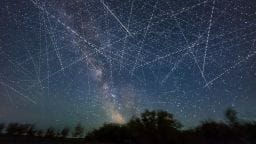A mysterious, fiery object fell from the sky into Mukuku village in Kenya’s Makueni County on Monday, leaving residents in awe and prompting a swift response from the Kenya Space Agency (KSA). The agency has since identified the object as a large metallic ring—a piece of space debris likely originating from a rocket. This incident highlights the growing challenge of space debris in Earth’s orbit and the associated risks to communities worldwide.
Discovery of the Object
Local residents were the first to spot the red-hot object as it crashed through the trees, stirring curiosity and concern. Authorities quickly secured the site, with Mbooni Sub County Police Commander Julius Rotich describing the object as intensely hot upon their arrival. As the area was cordoned off for safety, intrigued onlookers gathered around while officials began a preliminary investigation.
The KSA, the country’s national space agency, took custody of the fragment, which is 2.5 meters (8 feet) in diameter and weighs an estimated 500 kilograms (1,100 pounds). According to their statement, this metallic ring is believed to be a “separation ring,” a critical part of a rocket used to detach stages during space missions. While most space debris either burns up in Earth’s atmosphere or falls into remote areas such as oceans, this object was an exception, landing in the rural village.
Preliminary Investigation and Analysis
The KSA is collaborating with relevant experts to trace the origin of the space junk. Determining the source involves analyzing design features, material composition, and any visible markings that might point to a specific rocket or space mission. While these types of incidents are rare, they highlight an increasing need for space agencies to monitor and address the problem of deorbiting debris.
Also Read : NASA’s Mars Mission Finds Potential Signs of Life, Plans Retrieval Operation
Space debris encompasses defunct satellites, spent rocket stages, and smaller fragments resulting from collisions or explosions in orbit. An ever-growing population of such debris has raised concerns over the safety of active spacecraft, orbital stations, and the planet’s surface.
Broader Context of Space Debris
The Mukuku incident underscores a global issue—the proliferation of space debris in Earth’s orbit. Over the last few decades, humanity’s reliance on satellites for communication, navigation, and research has resulted in a massive increase in orbital objects. Visual depictions of the sky at night reveal countless satellite streaks that move in various patterns, illuminated by sunlight at high altitudes.
For instance, low Earth orbit (LEO) is particularly crowded, with satellites like SpaceX’s Starlink constellation forming prominent west-to-east trails. Many Earth observation satellites traverse north-south paths, contributing to the dense network visible to observers. Images of the sky, taken during longer exposures, showcase the intersection of these paths with an occasional natural phenomenon like a meteor streaking through.
Kessler Syndrome and the Space Junk Crisis
The problem of uncontrolled debris falling to Earth is compounded by a broader issue known as Kessler Syndrome. This theoretical scenario, proposed by NASA scientist Donald J. Kessler in 1978, describes a cascade of orbital collisions creating a dense field of debris. If realized, this could render certain orbits unusable for satellites and spacecraft, further complicating space operations.

Already, isolated incidents of collisions have caused concern among experts. In one notable case, a failed satellite reentered Earth’s atmosphere uncontrolled, creating widespread fear. Although the majority of space debris is directed into “graveyard orbits” or remote oceanic regions upon reentry, unpredictable variables occasionally result in objects reaching populated areas, as seen with the Mukuku fragment.
Safety Measures and International Collaboration
The Kenya Space Agency has assured the public that this isolated event is under investigation and does not currently pose an ongoing threat. However, it underscores the need for proactive measures to track space debris. Globally, agencies like NASA, ESA, and private companies are exploring methods to mitigate the risks of orbital junk.
Strategies include:
- Tracking and Monitoring: Advanced systems to monitor and predict the movement of debris, ensuring better risk management for active missions.
- Active Removal: Technologies like robotic arms, nets, and even lasers are being developed to remove defunct satellites and large fragments from orbit.
- Regulations and Standards: Establishing international guidelines for satellite deorbiting and rocket design to minimize long-term debris.
This cooperation is essential, as the challenges posed by orbital debris require concerted global action.
Local Impact of the Incident
The incident in Mukuku offers a stark reminder that space exploration has tangible effects on Earth. While the idea of space debris reentering Earth’s atmosphere might seem distant. This event shows how rural communities can unexpectedly encounter these remnants.
Fortunately, no injuries or property damage were reporte, but the safety concerns are not negligible. Residents described the moment of the crash as shocking, with some fearing. It could be link to supernatural phenomena until officials arrived and clarified the situation.
Implications for Kenya’s Space Industry
For Kenya, this event sheds light on the need to further develop its space capabilities. While still nascent, the country’s space program has achieved milestones like launching nano-satellites and conducting space science research. With greater investments in satellite technology and orbital tracking. Kenya could contribute to regional and global efforts in mitigating space debris.
Events like this also present opportunities for public education. By sharing information about this exploration and its side effects, agencies. It can inspire interest in science, technology, engineering, and mathematics (STEM). While addressing public concerns about safety.
Conclusion
The fall of a space debris fragment into a Kenyan village serves as both a warning and an opportunity. It underscores the reality of increasing orbital congestion and the associated risks while also highlighting the need for proactive solutions. As the Kenya’s Agency continues its investigation, global cooperation in space debris management becomes ever more critical. Through innovative technologies, better regulations, and robust the programs. The risks associated with uncontrolled debris, it can be mitigate, ensuring the safety and sustainability of space exploration.

